four decades between surfing and myth making
- Written by Alfio Leotta, Senior Lecturer, Victoria University of Wellington
Over the last 40 years, John Milius’ surf cult movie, Big Wednesday (1978), has made a mark on global popular culture. It inspired the names of things as disparate as the weekly New Zealand lotto draw, an Australian pale ale and countless storms and hurricanes.
In particular, Milius’ film had a huge impact on surfing subculture, both in shaping the international perception of the sport and providing one of the most authentic depictions of Californian surfers during the 1960s and 1970s. Big Wednesday went as far as moulding surfing iconography. The fictional “Bear surfboards” logo and t-shirts, originally created by the filmmaker as props for the film, went on to become a popular surf trademark owned by Milius himself.
When John Milius made Big Wednesday in 1978, he was considered one of the most promising filmmakers in Hollywood.Although today Big Wednesday is considered one of the best surf movies ever made, the path that led to its cult status was a long and convoluted one.
Big hopes
When the film was released in May 1978, everybody – the director, the producer and the prospective viewers – had big hopes for it. By the late 1970s surfing had become a fashionable, popular global sport. Milius, well-known for his involvement in successful productions such as Jeremiah Johnson, Dirty Harry and The Wind and the Lion, was considered to be one of the most promising filmmakers in Hollywood.
According to a famous Hollywood legend, Big Wednesday was part of a three-way profit point swap between Milius and his old friends, George Lucas and Steven Spielberg. However, while Star Wars (Lucas) and Close Encounters (Spielberg) would haul in hundreds of millions of dollars, Big Wednesday was a major critical and popular wipe-out, at least initially. It made only US$4.5 million (half of its original budget) at the box office.
The film is set in California between 1962 and 1974 and follows the lives of three surfers: Matt Johnson (Jan-Michael Vincent), a self-destructive local surf star, and his two best friends, Leroy “The Masochist” Smith (Gary Busey) and Jack Barlowe (William Katt).
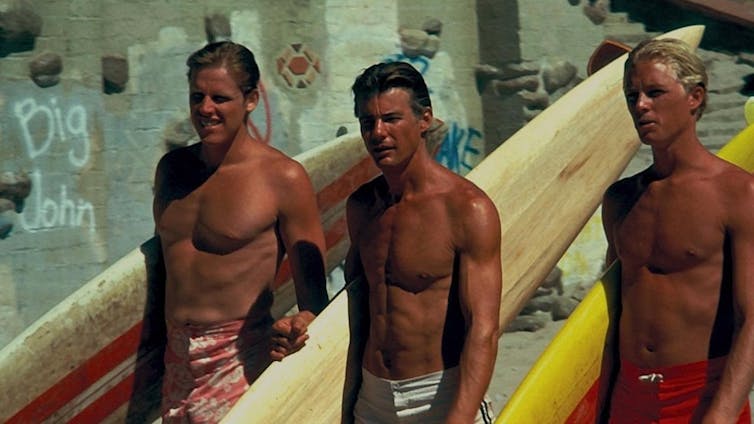 From left, Gary Busey, Jan-Michael Vincent and William Katt in Big Wednesday.
A-Team See more/idmb
From left, Gary Busey, Jan-Michael Vincent and William Katt in Big Wednesday.
A-Team See more/idmb
A coming of age story, it chronicles the three characters’ transition to adulthood with parties, surf trips, marriage and the Vietnam War in the background. In the last sequence of the film, the three are reunited to face the “Great swell of 74”, which represents the final moment in this maturation process.
From box office wipe-out to cult success
Some commentators ascribed the early critical and commercial failure of Big Wednesday to its excessive sentimentality. According to surf journalist Paul Gross, hard-core surfers found the film too cheesy. Other potential explanations suggested that in the late 1970s, the Vietnam wound was still too fresh and binge drinking, a prominent feature of the film, had lost its flavour.
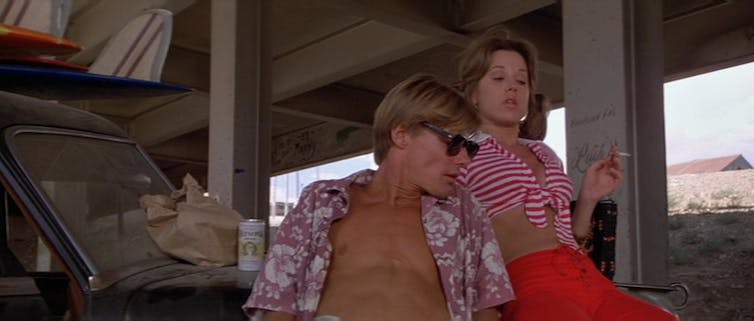 Jan-Michael Vincent and Lee Purcell in Big Wednesday.
A-Team See more/idmb
Jan-Michael Vincent and Lee Purcell in Big Wednesday.
A-Team See more/idmb
Most importantly, upon its release, Big Wednesday’s premise that passion for surfing had an expiration date was unthinkable. However, the rapid commodification of surfing culture that occurred during the late 1970s and 1980s made Big Wednesday’s nostalgic celebration of a “pure” surfing culture relevant again.
Following its home video release in the 1980s, the film gradually acquired cult status. It become one of the most influential surf movies ever made. The cult success lay in its ability to combine the accurate observation of real people and events, the reproduction of believable stunts and performances, and a supercharged sense of the mythic. Much of the authenticity of the film was due to the fact that Milius was himself an avid surfer.
A surfer cum director
In a 1976 interview, when he was still at the beginning of his career, Milius claimed that “my religion is surfing”. In the late 1950s, Milius surfed regularly in Malibu, where he met Denny Aaberg, the brother of surf legend Kemp Aaberg and the future co-writer of Big Wednesday.
Originally Milius envisioned the story as a novel and he included the treatment in a letter, entitled “We were gods”, to literary agent Lynn Nesbit. Milius said that while the story was inspired by his own life experiences as a young surfer in Malibu, he was interested in achieving a balance between a realistic depiction of true events and the mythologising of surfers and surfing culture.
In Milius’ words:
We were outlaws, juvenile delinquents, anarchists and rascals. And at the same time our lives were regulated by a strict chivalry code. We were samurai.
In 1971, Milius discussed the idea of writing a book about their youth in Malibu with his Aaberg. In 1975, Warner Bros expressed a strong interest in Milius’ idea about a surf film, which in turn prompted him to buy the rights to the title of John Severson’s 1961 surf movie Big Wednesday.
Only on Wednesdays
Severson’s title referred to a surfing myth according to which all the great surf days of the year fall on Wednesdays. The seemingly paradoxical juxtaposition between an ordinary day (Wednesday) and epic adjective (Big) also matched Milius’ double ambition to provide both a realistic account of surfing subculture and to create a long-lasting surf mythology.
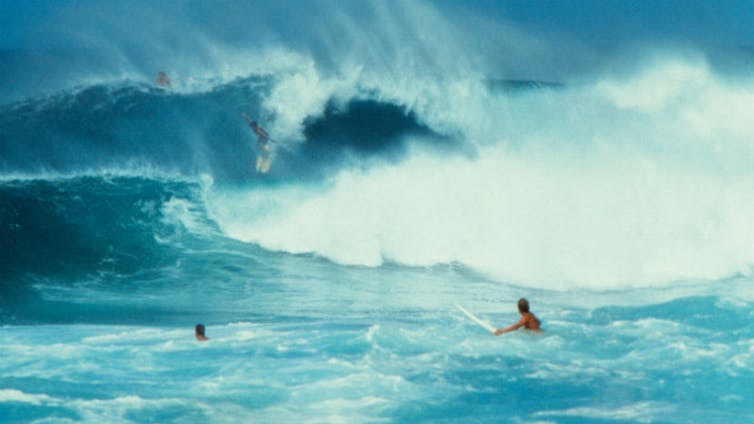 A surf scene from the film.
A-Team See more/idmb
A surf scene from the film.
A-Team See more/idmb
Milius and Aaberg based their script on their own stories about Malibu, which in the film would be referred to as “The Point”. All the main characters were inspired by real people, in particular surf legends Lance Carson and Kemp Aaberg and surfboard makers Hap Jacob and Dale Velzy. Similarly, most of the sequences of the film, including the iconic Vietnam draft dodging scene and the trip to Mexico, were based on the filmmakers’ own real-life experiences.
The film’s authenticity was enhanced by Milius’ connection to the surfing world, which enabled him to bring in experienced surf documentary maker Greg MacGillivray. MacGillivray, in turn, supervised a team of surf cinematographers. Several surf legends – Peter Townend, Ian Cairns, Jay Riddle and Bill Hamilton – were involved in the making of the film as stunt coordinators or doubles. Surf star Gerry Lopez, who would later appear as an actor in other films directed by Milius, played himself in the last sequence of the film.
The birth of a myth
The film’s success, as demonstrated by its great popularity in countries such as Italy where surfing is not a prevalent sport, was not limited to its depiction of surfing subculture. The film engaged with universal themes such as the passage to adulthood and the nostalgic celebration of an irrevocably lost golden age. While working on the script, Milius and Aaberg used Samurai stories, the Arthurian saga and Herman Melville’s Moby Dick as sources of inspiration.
Milius created a mythical aura around the protagonists of Big Wednesday. They were depicted as both titanic figures who embody physical perfection and barbarians who refuse to conform to the rules of civilised society. The opening and closing sequences of Big Wednesday feature the three protagonists walking through the ruins of a decaying portico like kings of an ancient civilisation where traditional values such as heroism, courage and loyalty are still upheld.
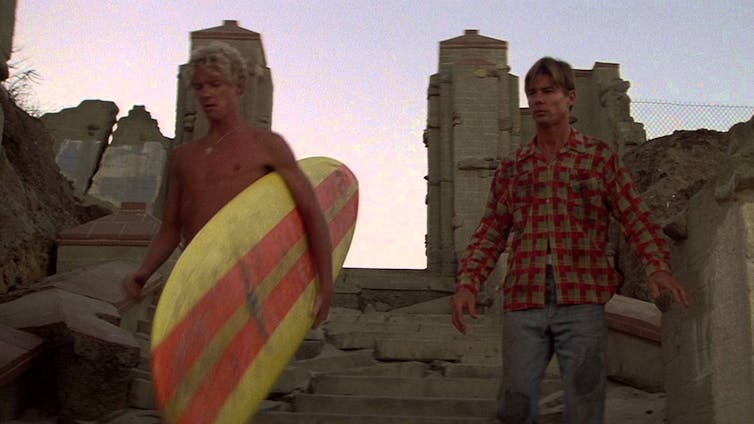 The heroes are depicted as walking like the kings of an ancient civilisation.
A-Team See more/idmb
The heroes are depicted as walking like the kings of an ancient civilisation.
A-Team See more/idmb
The nostalgic celebration of friendship is strongly associated with the critique of contemporary capitalist American society. Similarly, the ocean and the American west coast symbolise the possibility of a return to the frontier, the physical and symbolical home of the “authentic” American character. In Milius’ film, the surfers are the last true American pioneers whose courage and heroism are forged by their ability to live at the intersection between nature and culture.
The idea of the ocean as the new Far West is reinforced by the film’s references to Milius’ favourite Westerns, including The Wild Bunch (the scene in which four characters walk to the draft office) and The Searchers (Hank Worden, the actor who played Mose Harper in Ford’s classic was cast as one of the secondary characters in Big Wednesday).
Milius, Big Wednesday and its legacy
Surf is a reoccurring trope in Milius’ work. He was also responsible for the creation of the surf-obsessed Captain Kilgore and some of the most iconic lines (“Charlies don’t surf”) in Apocalypse Now (1979). In the 1980s, Milius would go on to make commercially successful films such as Conan the Barbarian and Red Dawn. However, in the 1990s and 2000s his career declined rapidly.
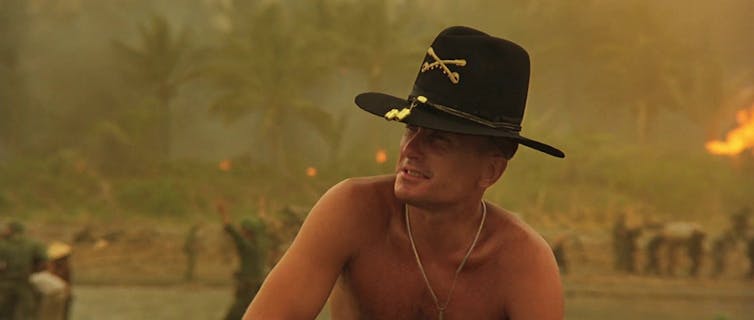 Milius was later responsible for the creation of the surf-obsessed Captain Kilgore (Robert Duvall) in Francis Ford Coppola’s Apocalypse Now.
Zoetrope Studios
Milius was later responsible for the creation of the surf-obsessed Captain Kilgore (Robert Duvall) in Francis Ford Coppola’s Apocalypse Now.
Zoetrope Studios
Although Milius, a self-proclaimed gun-loving Zen Anarchist, blamed Hollywood executives for blacklisting him on the grounds of his outspoken right-wing beliefs, his decline was caused, more likely, by a series of box-office flops and a stroke in 2010. To date Milius’ last major film-making credit is as creator of the acclaimed HBO TV show Rome in 2005. He features prominently in two documentaries about surfing: Hollywood Don’t Surf and Between the Lines: Surfers during the Vietnam War.
While Milius has been forgotten by most contemporary viewers and critics, the legacy of Big Wednesday continues to live on. Forty years after its release the passion and lyricism of the film are even more compelling. The mythical resonance of the Big Wednesday, the hump-day, when the week’s beginning tips into its end, when the gods of surf and youth reach the apex of their glory, continues to fascinate new generations of viewers.
Authors: Alfio Leotta, Senior Lecturer, Victoria University of Wellington
Read more http://theconversation.com/big-wednesday-four-decades-between-surfing-and-myth-making-95859





